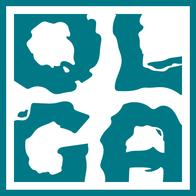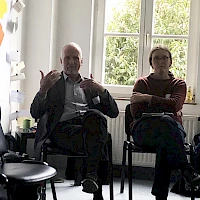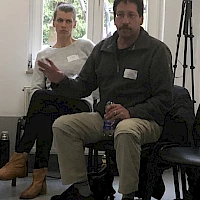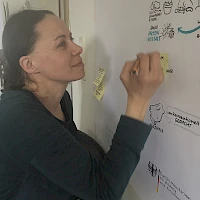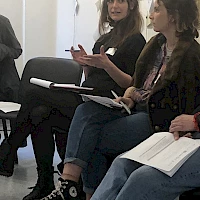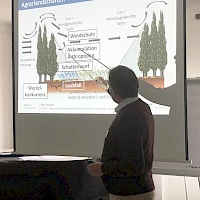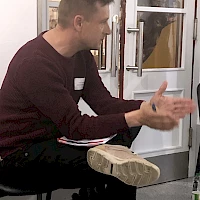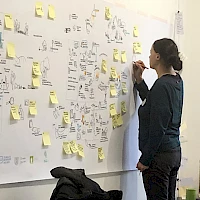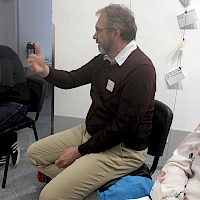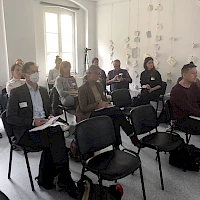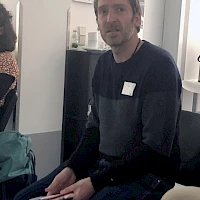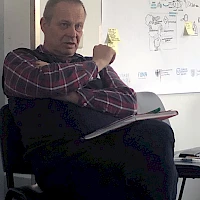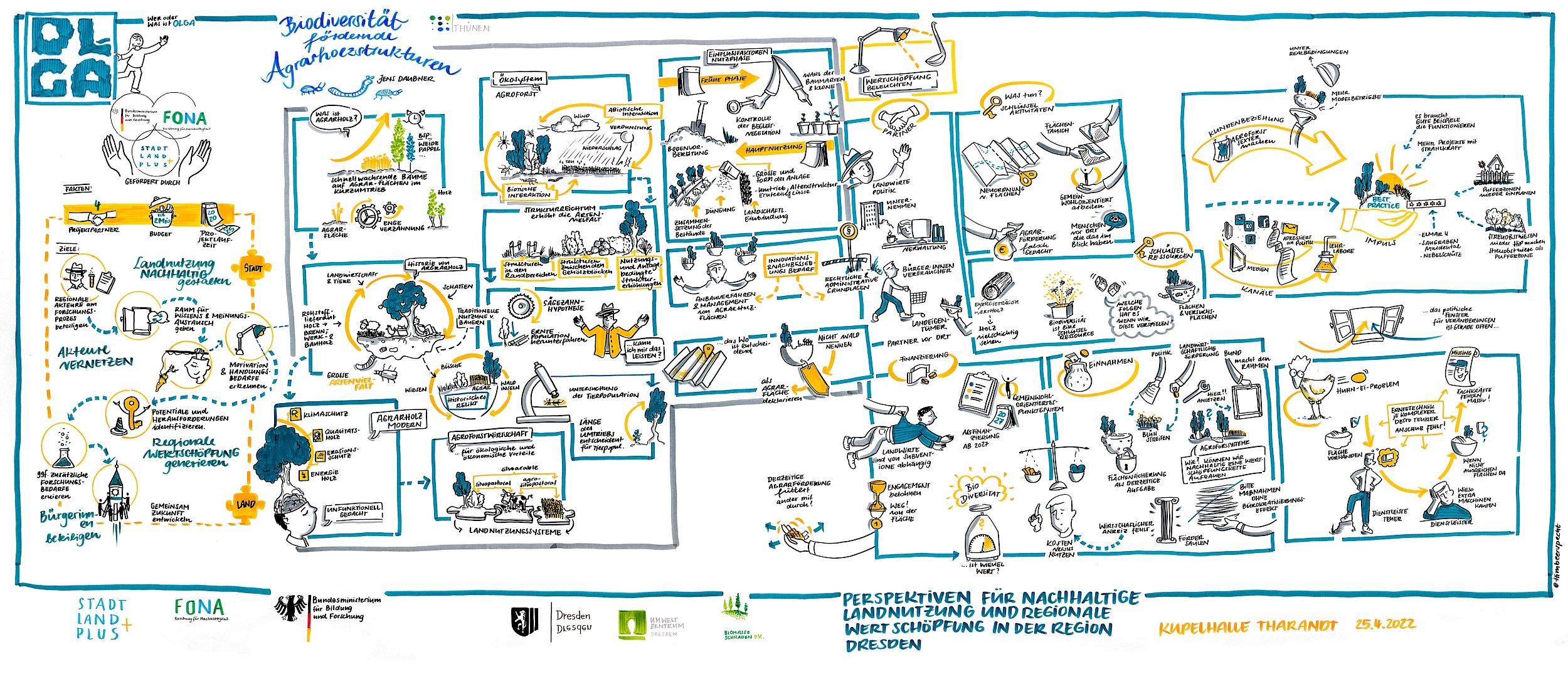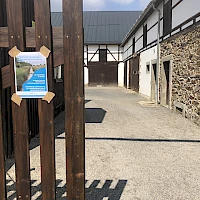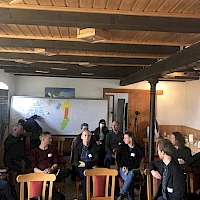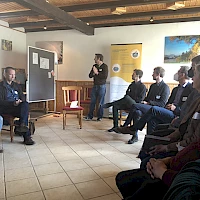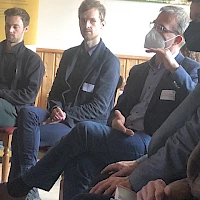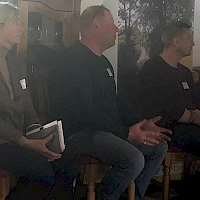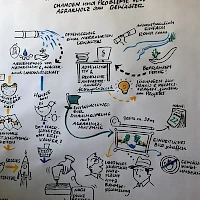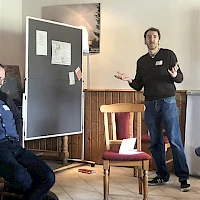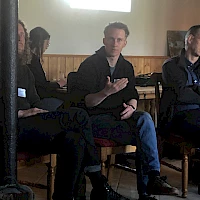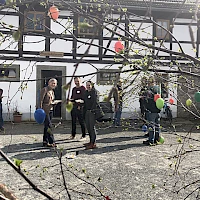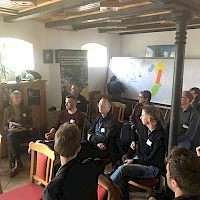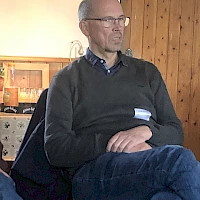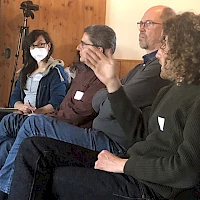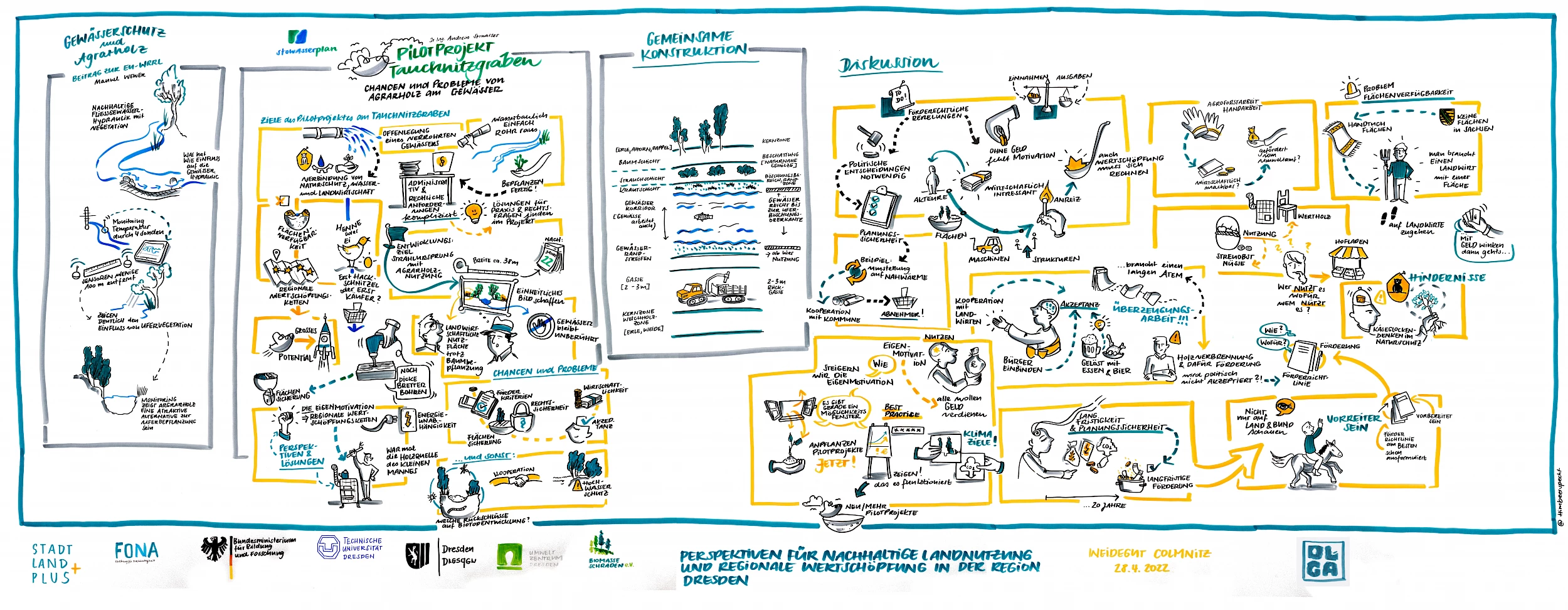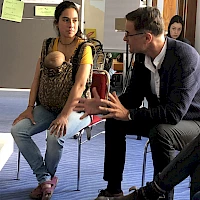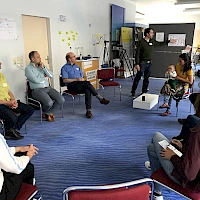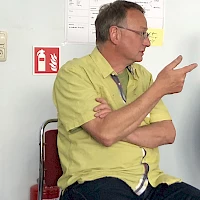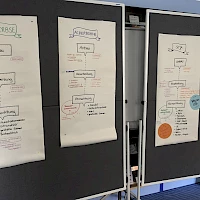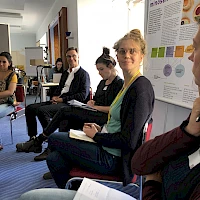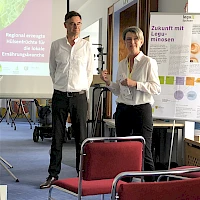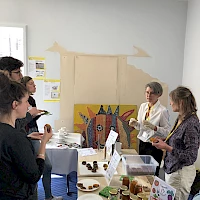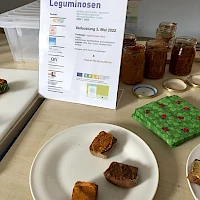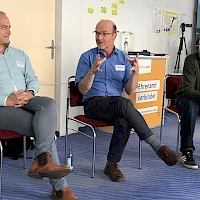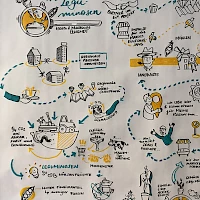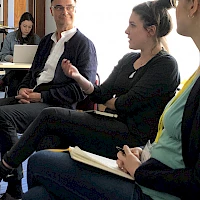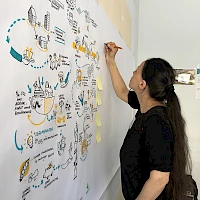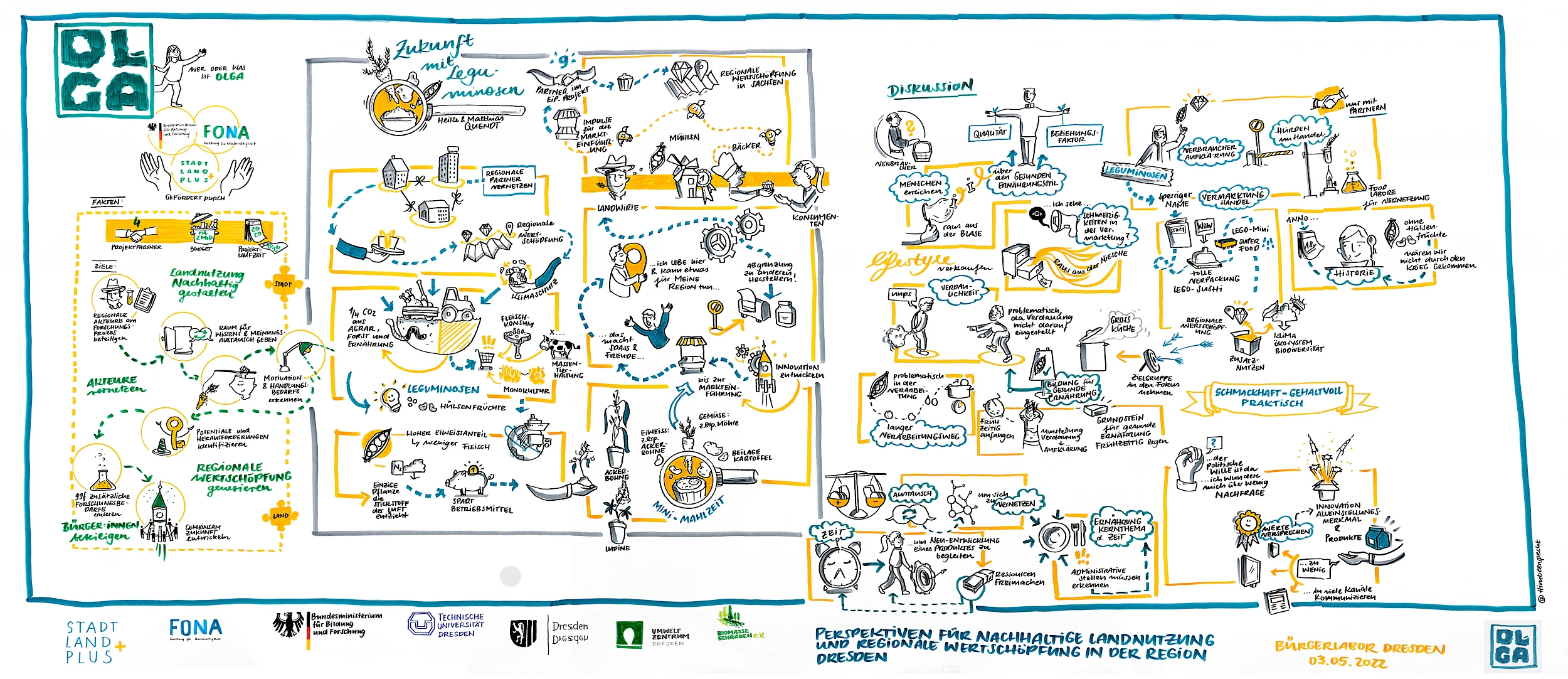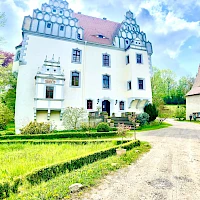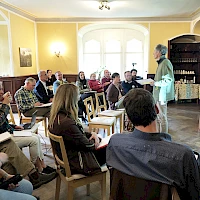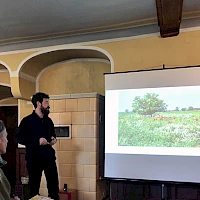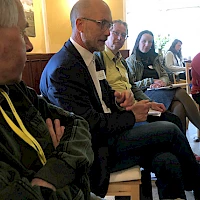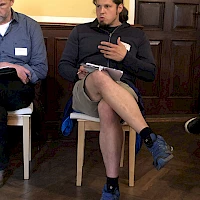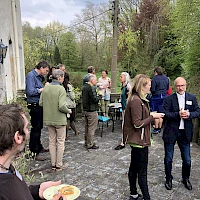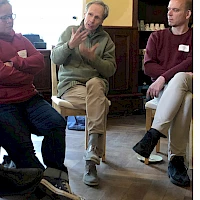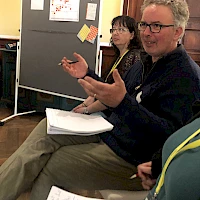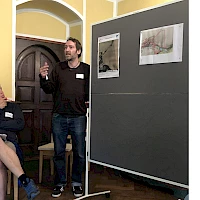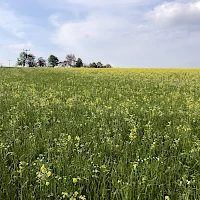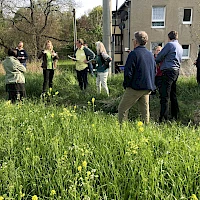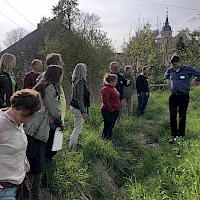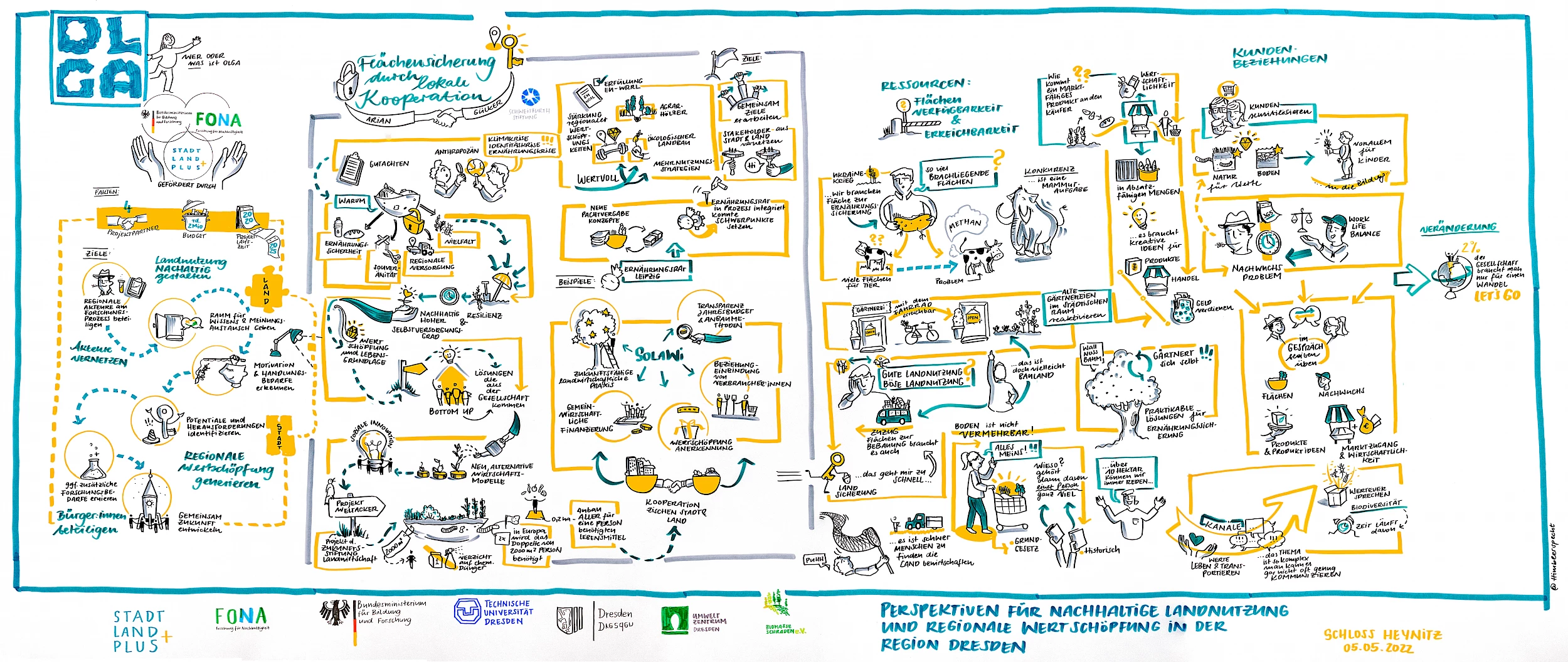Prospects for sustainable land use and regional value creation in the Dresden region
Focus group "Promoting biodiversity through the cultivation of agricultural wood systems - unrealistic or feasible?"
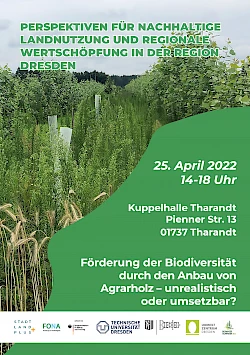 Agricultural wood structures are special forms of agroforestry systems that focus on fast-growing tree species such as poplar or willow. They are usually cultivated in rows or over a wide area, and after a certain rotation period they are cut down and, among other things, processed into wood chips and burned for heat production.
Agricultural wood structures are special forms of agroforestry systems that focus on fast-growing tree species such as poplar or willow. They are usually cultivated in rows or over a wide area, and after a certain rotation period they are cut down and, among other things, processed into wood chips and burned for heat production.
For the integration of semi-natural hedges, shrubs, mixed tree species, flowering strips and other elements to promote biodiversity in the agrowood system, the harvesting technology, i.e. the machinery etc., must also be adapted accordingly, which is viewed critically by some farmers due to the additional costs incurred. What is the point if the yield does not cover my expenses?
In order to increase the supply of agricultural wood and correspondingly cultivated structures on arable land in the Dresden region, the entire value chain from cultivation to harvesting, processing and distribution must be considered. First and foremost, it is a question of economic efficiency, and only then does one think about biodiversity. Unless there is support for agroforestry or agrowood, which at € 60/ha is not yet very lucrative for farmers. For the next CAP 27+, it is already time to make sensible and well-founded proposals for the integration of agroforestry with all its environmental services into the support catalogue. This also requires a rethinking of the agricultural control and accounting system, which should much more consider and appreciate multifunctional land use systems that provide both value and energy wood as well as fruits, at the same time protect against erosion, bind CO2, provide shade and retent water on the field and on top of that also promote biodiversity.
Focus group "Sustainable land use along watercourses through agrowood structures"
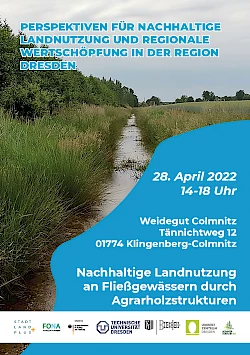 In the end, all participants of the OLGA focus group agreed: The integration of agroforestry structures in combination with other woody plants in the riparian strip is possible and makes sense in a near-natural and multifunctional system. Crucial for initiating such development processes is communication at eye level between agriculture, water protection and nature conservation. If no compromises can be found here, the entire project is in danger of collapsing.
In the end, all participants of the OLGA focus group agreed: The integration of agroforestry structures in combination with other woody plants in the riparian strip is possible and makes sense in a near-natural and multifunctional system. Crucial for initiating such development processes is communication at eye level between agriculture, water protection and nature conservation. If no compromises can be found here, the entire project is in danger of collapsing.
The interest and motivation for the cultivation of agrowood structures and its utilisation must come from the farmer or landowner himself. For this, well communicable demo projects are needed, which can show the potentials but also the challenges of such a structure, including the topics of planting, (technical) management and maintenance, value creation and the contribution of these structures to climate adaptation, soil revitalisation, erosion control and biodiversity. In addition, for the new CAP from 2027 onwards, there needs to be a separate funding guideline for the implementation of agroforestry systems with lucrative funding rates for the farmer.
Through a practice area of agroforestry in the riparian strip of smaller water courses in the OLGA project and through various practice-relevant actions for farmers, politics and administration in the Dresden region, we will try to communicate the advantages of this form of land use in the region in the hope that land owners and farmers will discover agroforestry for themselves. Not least because of the current economic and political circumstances!
Focus group "Regional pulses for the local food industry"
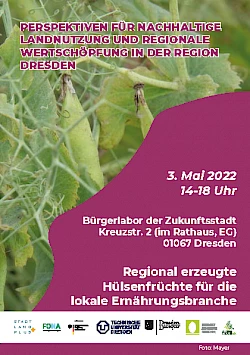 It needs to be a creative, appealing and sexy product - via the packaging, the design, the quality of the food itself and ultimately the unforgettable taste experience so that people buy it once and again. So how can products with legumes be communicated and marketed more successfully so that they get out of their niche and the legume market in human nutrition picks up speed in the Dresden region and in Saxony?
It needs to be a creative, appealing and sexy product - via the packaging, the design, the quality of the food itself and ultimately the unforgettable taste experience so that people buy it once and again. So how can products with legumes be communicated and marketed more successfully so that they get out of their niche and the legume market in human nutrition picks up speed in the Dresden region and in Saxony?
Many legumes are already cultivated in Saxon agriculture, but so far they have mostly been grown for animal feed and often as catch crops. Here it is important to get an overview of which farmers grow which legumes in order to be able to quantify the approximate quantity purchased per year. The processing of many legumes, which have to be dried and peeled before they can be processed into edible food, is still a challenge. Many farms lack the machinery. These could be shared in the form of cooperations or the lack of technology could be compensated for by mobile formats, such as a soy toaster.
It is important that the actors along the entire value chain, e.g. for lupine, know about each other - from production via processing to marketing. In Dresden and the region, there need to be more places where these people can come together, test products together, cook, taste and talk to each other - e.g. in the context of food and cook events etc.. Finally, food and product research should not be missing here either. In Dresden there are already numerous food start-ups that are open towards the development of products with legumes. There are already good approaches. More effort and cooperation is needed to establish various products with legumes on the regional market. Heike and Matthias Quendt from Quendt Food Innovation KG have already developed their mini-meals with legume dough and are trying to bring them to consumers via Saxon bakeries. The organic shops in Dresden, the Verbrauchergemeinschaft Dresden or Marktschwärmer could also be potential buyers of the products. OLGA will continue to support this process and strives for an implementation project together with the practical partners.
Focus group "Vegetable pool 3.0 - Access zu land for growing regional food"
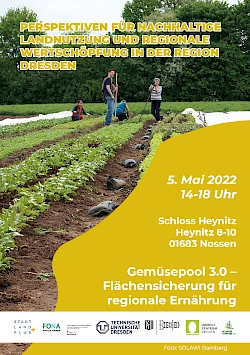 Competition for land is greater than ever before. A lot of land in Saxony is also used for export, the production of animal feed (delicious legumes!) and bioenergy. When it comes to the allocation of land, people are often powerless. Terms such as "share deals" - land share purchases by non-farming investors who have a larger share of the land market in Germany under their control - and "right of first refusal" were mentioned in the focus group. All developments that make it impossible for the "small farmer" to participate equally in the competition for affordable land. Nevertheless, there are some initial success stories in Saxony, such as the voluntary leasing of land from a Saxon agricultural cooperative to a solidarity farming initiative (SoLawi in German) that is in the process of being founded, or the reorganisation of the leasing criteria of the City of Leipzig in favour of sustainable, climate-adapted cultivation.
Competition for land is greater than ever before. A lot of land in Saxony is also used for export, the production of animal feed (delicious legumes!) and bioenergy. When it comes to the allocation of land, people are often powerless. Terms such as "share deals" - land share purchases by non-farming investors who have a larger share of the land market in Germany under their control - and "right of first refusal" were mentioned in the focus group. All developments that make it impossible for the "small farmer" to participate equally in the competition for affordable land. Nevertheless, there are some initial success stories in Saxony, such as the voluntary leasing of land from a Saxon agricultural cooperative to a solidarity farming initiative (SoLawi in German) that is in the process of being founded, or the reorganisation of the leasing criteria of the City of Leipzig in favour of sustainable, climate-adapted cultivation.
But once there is access to land, there also needs to be people to cultivate it. A major problem today and in the future is the recruitment of young people in agriculture and horticulture. New incentives and attractive training opportunities are needed for young people or people who want to retrain. A SoLawi in the Dresden area is currently fortunate to have committed, trained gardeners among its members, who tend and care for the fruits on the one-hectare field. Without them it would not work.
In Dresden there are now and in the future even more abandoned nursery sites that could be wonderfully used for growing vegetables for the SoLawis in the neighbourhood and for other agricultural projects in urban areas. But the owners do not want to give up their land for various reasons. The networking of land owners and tenants - in the form of a digital land exchange or a regular citizens' get-together for direct personal exchange - were ideas that were shared at the focus group.
As with the other focus groups, good examples are needed of how access to land can be created, sustainably managed and, if necessary, how several uses can be combined. Right next to the castle, there is the possibility of setting up a demonstration area for sustainable land management, e.g. in the form of an agroforestry system, and involving the citizens of Heynitz in the planning and implementation. Discussions on feasibility and implementation of this potential future action will take place in the coming weeks.
At the end of 2021, when the focus groups were supposed to take place but had to be postponed because of Corona, online exchanges took place with the participants who had already registered. Here, important moods, opinions and suggestions could already be collected for the face-to-face events in spring 2022. A short summary of the online pre-session can be found HERE.
